Navigating roads safely, whether as a driver, cyclist, or pedestrian, relies heavily on understanding street signs and their meanings. These visual cues are universally designed to communicate vital information quickly and effectively, ensuring smooth traffic flow and minimizing accidents. From guiding you to your destination to warning you about potential hazards, street signs are indispensable for road safety. Whether you’re a seasoned driver brushing up on your knowledge or a new learner preparing for your driving test, understanding the different categories and meanings of street signs is crucial. Let’s delve into the world of street signs and unlock the essential knowledge they offer for safer journeys.
Regulatory Street Signs: Obeying the Law of the Road
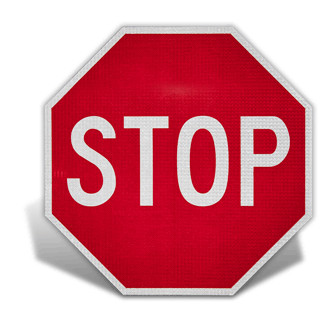 Red stop sign, a regulatory street sign indicating drivers must come to a complete stop.
Red stop sign, a regulatory street sign indicating drivers must come to a complete stop.
Regulatory street signs are the backbone of traffic law, dictating the rules that every road user must follow. These signs set clear guidelines for speed limits, parking regulations, lane usage, and prohibited actions, ensuring order and preventing chaos on roadways. Recognizing and adhering to regulatory signs is not just about following rules; it’s about contributing to a safer environment for everyone.
Characterized by their white or red backgrounds, regulatory signs are easily identifiable. Signs with a white background typically employ a black or red legend (text and symbols) to convey instructions. Notably, critical regulatory signs like stop signs and yield signs feature a distinctive red background with a white legend, immediately signaling high importance.
Here are some essential examples of regulatory street signs you’ll encounter:
- Stop Sign: Octagon shaped, always red with white letters. Indicates you must come to a complete stop before proceeding when it is safe.
- Yield Sign: Inverted triangle, usually red and white. Means you must give way to other traffic or pedestrians.
- Speed Limit Signs: Rectangular, white background with black numbers. Shows the maximum legal speed limit for the road.
- Do Not Enter: White square with a red circle and white horizontal bar. Indicates you are not allowed to enter a road or area.
- One Way Signs: Rectangular, white background with a black arrow. Shows traffic is allowed to travel in one direction only.
- No Parking Signs: Various designs, often white with red elements. Indicate areas where parking is prohibited or restricted.
Understanding and respecting regulatory street signs is paramount to safe driving and legal compliance. Always be vigilant for these signs and adjust your driving behavior accordingly.
Warning Street Signs: Anticipating Roadway Hazards
 Yellow diamond street sign with a deer symbol, indicating a deer crossing area ahead.
Yellow diamond street sign with a deer symbol, indicating a deer crossing area ahead.
Warning street signs act as early alerts, informing drivers and road users about potential hazards, changes in road conditions, or unexpected situations ahead. Their primary function is to prompt caution and allow drivers ample time to react safely, mitigating risks and preventing accidents. By heeding warning signs, drivers can proactively adjust their speed, lane position, or driving strategy to navigate upcoming challenges effectively.
Easily recognized by their yellow background and black symbols or text, warning signs often come in a diamond shape, further enhancing their visibility and urgency. The bright yellow color is specifically chosen to grab attention, especially in daylight conditions, ensuring drivers are adequately forewarned.
Common examples of warning street signs include:
- Curve Ahead Signs: Diamond shaped, yellow with a black curved arrow. Warns of an upcoming curve in the road.
- Intersection Ahead Signs: Diamond shaped, yellow with a black cross or side road symbol. Indicates an upcoming intersection.
- Pedestrian Crossing Signs: Diamond or pentagon shaped, yellow with a pedestrian symbol. Alerts drivers to pedestrian crossing areas.
- Deer Crossing Signs: Diamond shaped, yellow with a deer symbol. Warns of areas where deer may frequently cross the road.
- Merge Ahead Signs: Diamond shaped, yellow with a merging arrow symbol. Indicates where traffic lanes will merge.
- Low Clearance Signs: Rectangular or diamond shaped, yellow with height restriction information. Warns of low overhead clearance, such as bridges or tunnels.
- Construction Zone Ahead Signs: (Often orange, but can be yellow for general warnings) Diamond shaped, yellow with construction symbols. Indicates upcoming road work zones.
Always pay close attention to warning street signs and adjust your driving accordingly. Reducing speed and increasing awareness when you see a warning sign can significantly improve safety.
Guide Street Signs: Navigating Your Route
Guide street signs are your navigational aids on the road, providing essential information to help you reach your destination efficiently and safely. They offer directions, distances, and identify landmarks, cities, and points of interest. Guide signs are particularly crucial on highways and interstates, ensuring drivers stay on course and make informed decisions about exits and routes.
Typically featuring a green background with white legends, guide signs are also found with blue or brown backgrounds depending on the type of information they convey. Green signs are predominantly used for highways and directional information, while blue signs often indicate services and brown signs highlight recreational or cultural sites.
Examples of guide street signs:
- Destination Signs: Green background with white text indicating cities, towns, or geographical locations. Often seen on highways and interstates.
- Exit Signs: Green background with white text and exit numbers. Indicate upcoming exits from highways.
- Route Markers: Various shapes and colors, often shield-shaped. Identify numbered highways and routes (e.g., Interstate, US Route, State Route).
- Street Name Signs: Typically green or blue, indicating the name of the street you are on.
- Mile Markers: Small green signs along highways indicating mileage from a starting point.
- Rest Area Signs: Blue background with white symbols. Guide drivers to rest areas and facilities.
- Hospital Signs: Blue background with a white ‘H’ symbol. Direct drivers to hospitals.
Utilize guide street signs proactively to plan your route and stay oriented, especially during long drives or in unfamiliar areas.
Service and Recreation Street Signs: Finding Amenities and Leisure
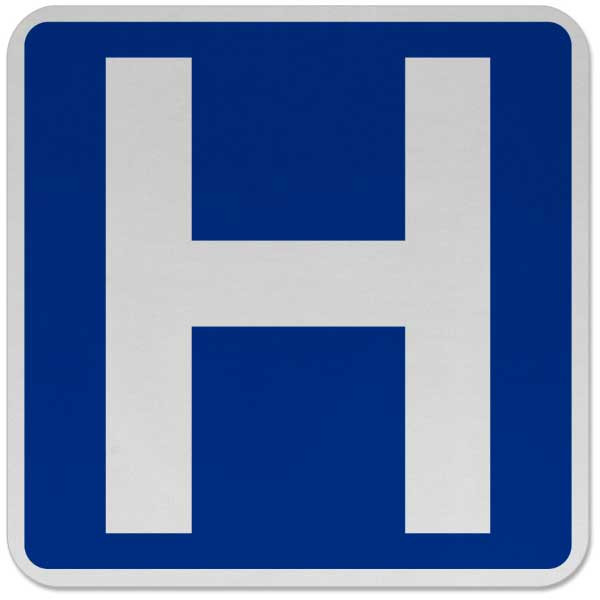 Blue street sign with a white symbol of a bed, indicating lodging services are available.
Blue street sign with a white symbol of a bed, indicating lodging services are available.
Service and recreation street signs are designed to enhance traveler convenience by pointing out essential services and recreational opportunities nearby. They guide motorists to amenities such as gas stations, restaurants, lodging, hospitals, and recreational areas, ensuring travelers can easily access necessary facilities and leisure activities during their journeys.
Similar to guide signs, these signs commonly use white legends on blue or brown backgrounds. Blue backgrounds generally denote services like gas, food, and lodging, while brown backgrounds are reserved for recreational and cultural points of interest such as parks, historical sites, and museums. Occasionally, white backgrounds with green legends are used for directional parking signs.
Examples of service and recreational street signs:
- Gas Station Signs: Blue background with a white gas pump symbol.
- Restaurant Signs: Blue background with a white fork and knife symbol.
- Lodging Signs: Blue background with a white bed symbol.
- Hospital Signs: Blue background with a white ‘H’ symbol.
- Rest Area Signs: Blue background with symbols for rest areas and restrooms.
- Campground Signs: Brown background with a white tent symbol.
- Park Signs: Brown background with symbols representing parks or recreational activities.
Service and recreation signs contribute to a more comfortable and enjoyable travel experience by making essential amenities and leisure options easily discoverable.
Temporary Traffic Control Street Signs: Navigating Changing Conditions
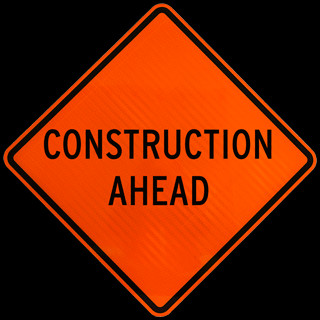 Orange roll up street sign with black text indicating 'Construction Ahead'.
Orange roll up street sign with black text indicating 'Construction Ahead'.
Temporary traffic control street signs are crucial for managing traffic flow safely and efficiently during temporary disruptions such as road construction, maintenance, or special events. These signs provide timely information about detours, lane closures, reduced speed limits, and other temporary changes in road conditions. Their purpose is to minimize confusion and potential hazards in dynamic situations, ensuring the safety of both road workers and drivers.
Temporary traffic control signs are predominantly orange with black legends, a highly visible color combination designed to stand out even in busy construction zones. The bright orange color immediately signals temporary or altered road conditions requiring extra caution.
Examples of temporary traffic control street signs:
- Construction Ahead Signs: Orange background with black text or symbols.
- Detour Signs: Orange background with black arrows and detour instructions.
- Lane Closure Signs: Orange background with symbols indicating lane closures.
- Reduced Speed Limit Signs (Temporary): Orange background with black speed limit numbers.
- Flagger Ahead Signs: Orange background with a symbol of a flagger.
- Road Work Ahead Signs: Orange background with text indicating road work.
Always be extra vigilant and prepared to adjust your driving when you encounter temporary traffic control signs. These signs indicate potentially hazardous conditions and require increased attention and caution.
Incident Management Street Signs: Responding to Emergencies
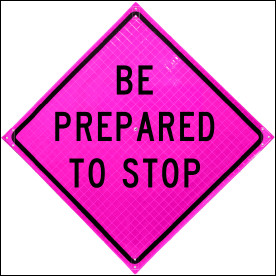 Pink diamond street sign with black text indicating 'DETOUR'.
Pink diamond street sign with black text indicating 'DETOUR'.
Incident management street signs, often recognized as pink road signs, are deployed to manage traffic flow during emergencies, accidents, or other unexpected incidents that disrupt normal roadway conditions. These signs provide critical information about detours, road closures, and alternative routes, facilitating efficient emergency response and minimizing traffic congestion during unforeseen events.
Distinguished by their bright pink or coral background and black legends, incident management signs are highly visible and immediately signal unusual or emergency road conditions. The distinctive pink color is specifically chosen for its uniqueness and ability to stand out from other standard traffic signs, ensuring drivers quickly recognize and respond to urgent information. Often diamond shaped to further emphasize hazard or special condition.
Examples of incident management street signs:
- Detour Signs (Emergency): Pink background with black arrows and detour instructions.
- Road Closed Signs (Emergency): Pink background with text indicating road closure.
- Flood Area Signs: Pink background with symbols warning of flooding.
- Accident Ahead Signs: Pink background indicating an accident ahead and potential delays.
- Emergency Route Signs: Pink background guiding drivers along designated emergency routes.
When you see pink incident management signs, be prepared for significant changes in traffic flow and follow the directions carefully to ensure your safety and facilitate emergency response efforts.
Pedestrian and Bicycle Street Signs: Sharing the Road Safely
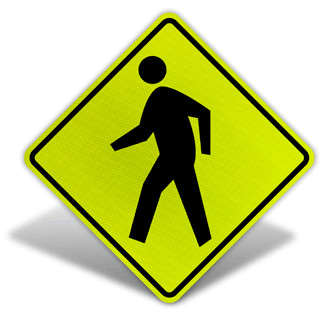 Yellow pentagon street sign with pedestrian symbol, indicating a pedestrian crossing area.
Yellow pentagon street sign with pedestrian symbol, indicating a pedestrian crossing area.
Pedestrian and bicycle street signs are dedicated to enhancing the safety of vulnerable road users – pedestrians and cyclists. These signs provide clear directives for both drivers and these non-vehicular road users, promoting safe interactions and shared use of roadways. They encompass a wide range of signs, from crosswalk markings to bicycle lane designations, all aimed at creating a safer environment for everyone.
Pedestrian and bicycle signs utilize a variety of background colors as they serve diverse purposes, ranging from warnings to regulations and guidance. Shapes also vary depending on the sign’s function, with diamond shapes often used for warnings and rectangular shapes for regulatory or guide information.
Examples of pedestrian and bicycle street signs:
- Pedestrian Crossing Signs: Yellow or fluorescent yellow-green pentagon or diamond shapes with pedestrian symbols.
- Bicycle Crossing Signs: Yellow or fluorescent yellow-green diamond shape with bicycle symbols.
- Share the Road Signs (Bicycles): Rectangular, often yellow or white, with text and bicycle symbols.
- Bike Lane Signs: Rectangular, green or white, indicating designated bike lanes.
- School Zone Crosswalk Signs: Often pentagon shaped, fluorescent yellow-green, warning of school zones and pedestrian crossings.
- Playground Signs: Pentagon shaped, fluorescent yellow-green, warning of playground areas.
- Yield to Pedestrian Signs: Rectangular, white, regulatory signs reminding drivers to yield to pedestrians.
Being mindful of pedestrian and bicycle street signs is crucial for creating a road environment where all users can travel safely and respectfully. Drivers must be especially attentive in areas with these signs and be prepared to yield or stop as needed.
Understanding the different types of street signs and their meanings is a fundamental aspect of road safety. By familiarizing yourself with these visual cues and reacting appropriately, you contribute to a safer and more efficient transportation system for everyone. Remember to stay informed and prioritize road safety in every journey.
